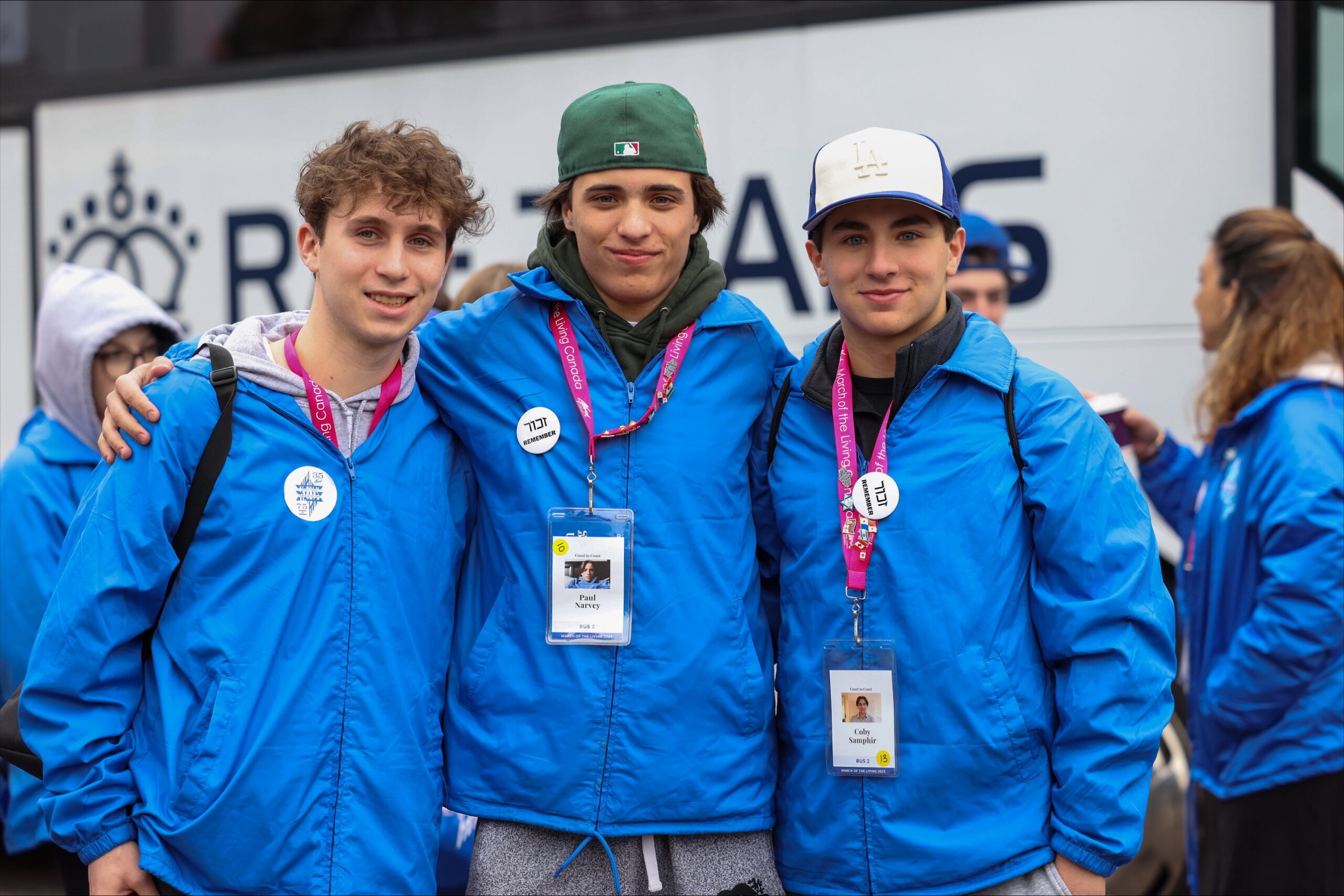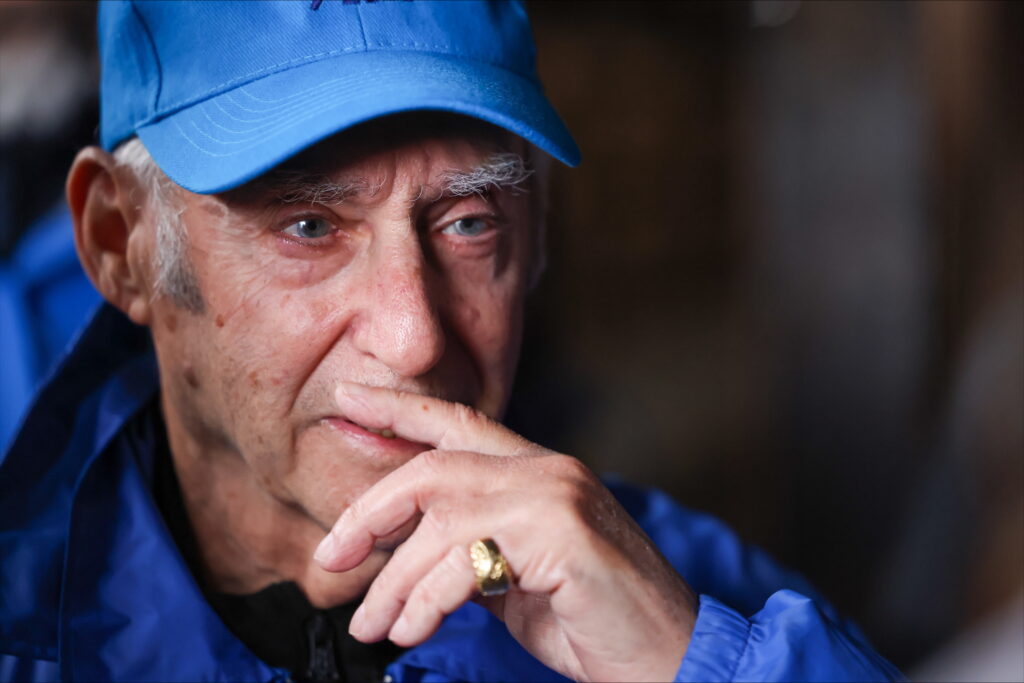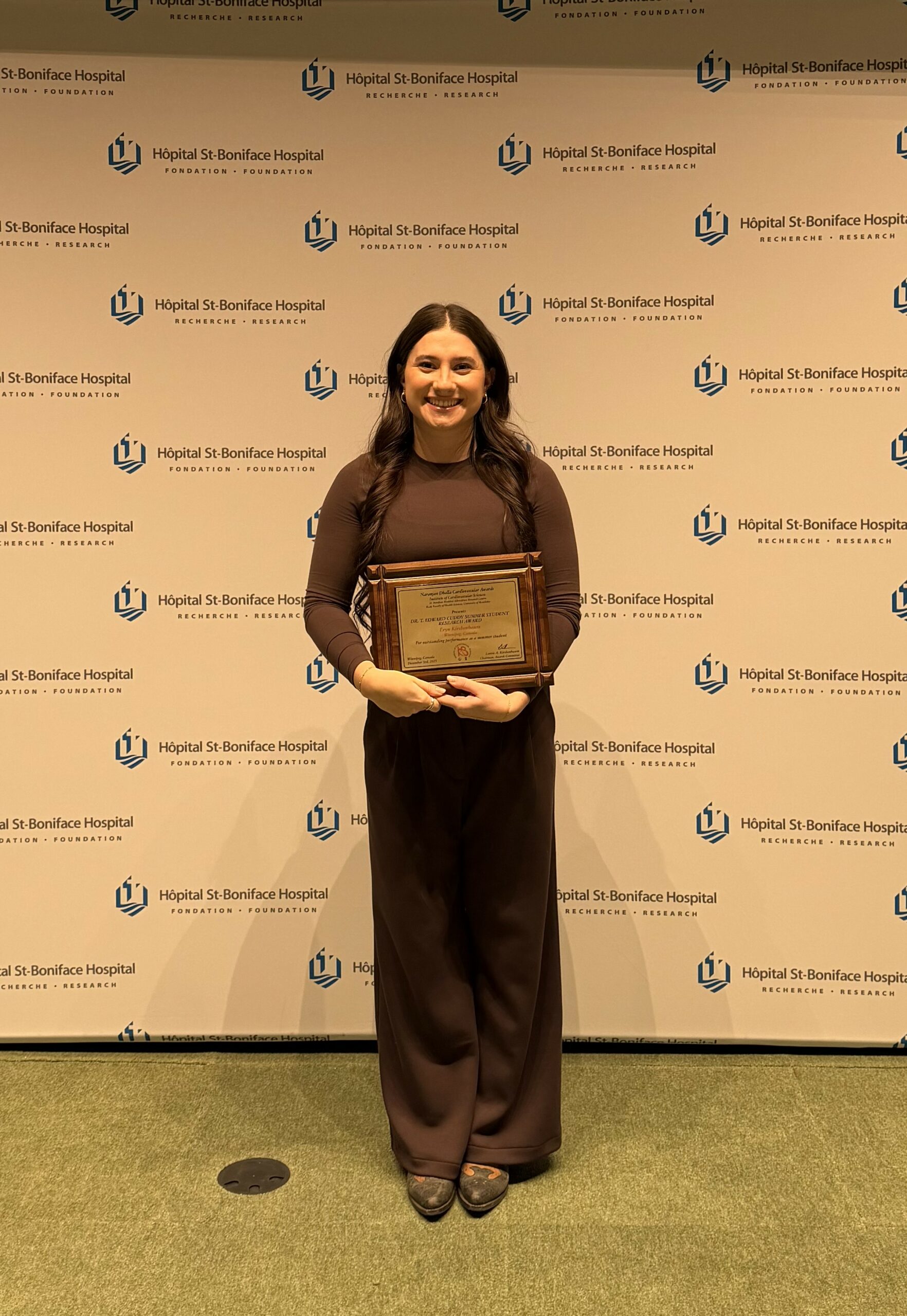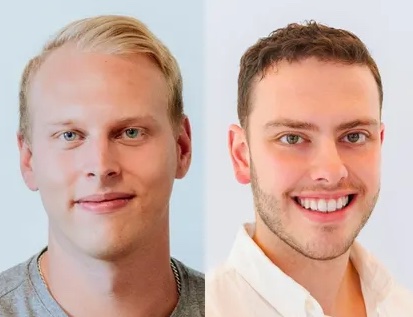Local News
Israeli hockey player Guy Rozin continues to improve his game playing in Canada

By BERNIE BELLAN
Elsewhere on this website you can read where I reported on the success that 17-year-old Michael Akbashev has had in the world of competitive judo (https://jewishpostandnews.ca/features/3111-two-years-ago-he-was-youth-ambassador-for-shalom-square-now-he-s-one-of-the-top-judokas-in-his-age-category-in-all-of-canada.)
Since I had written about Michael last year, it wasn’t all that difficult for me to remember what I had written.
But, when I decided to take a look at another young Israeli-born athlete whose story had been told in our paper, I was surprised to see that I, myself, had written the first story about Guy Rozin – three years ago to be exact, when Guy was 13 and when Guy and his family had just moved to Winnipeg from Israel – all so that Guy could further his hockey playing career.
You see, when I thought of writing about Guy again my first thought was that it was Scott Taylor who had written about Guy for our paper – last year. Then, when I reread Scott’s article, I was surprised to read that Scott was actually following up an article I had written.
In any event, when I contacted Guy on February 11, it was actually the first time I had spoken with him. Previously my contact was through Guy’s parents, Roie and Pnina. Back in 2017 Guy’s English would not have been good enough for me to interview him, and although he’s a typical teenager in that his answers were short – not the sort of long winded answers I’m more used to when interviewing older subjects, he still showed the same self-confidence that both Scott Taylor and I had noted when writing about him previously.
Just to recap – here’s a brief summary how Guy came to be playing hockey in Winnipeg: It was Abe Anhang who played a crucial role in bringing the Rozin family to Winnipeg.
In my 2017 article Abe explained his connection to the Rozin family: “My oldest friend from Winnipeg, Dr. Donald Silverberg (son of the late Jack Silverberg, who was a math teacher at St. Johns and ultimately the principal of JWC) lives in Netanyah. Dr. Donald Silverberg has a son, Monte, who is a lawyer in Israel and Monte Silverberg had a friend (and client) by the name of Roie Rozin. “Pnina (Roie’s wife) and Roie have always been sports people (Roie used to play professional soccer) and their kids are good at various sports – his daughter at gymnastics, their other son at tennis and their son Guy turned out to be an exceptional hockey player
“When I found out that Guy (at age 12) had been the European MVP (most valuable player) for two years in a row (in an in-line hockey tournament), it sort of got my attention. Then, wanting to see whether he could make it in Canada competitively, I suggested that Roie and Guy come to a hockey school, so they came for the summer of 2014. He did well there, so I introduced them and they met with the people at Federation who were extremely helpful! As a result, the Rozins applied for Permanent Residence under the Nominee Program (Pnina is a registered nurse, which was in demand then). They moved here in July of 2016 and got their landing card in January 2017. “Barbara (Anhang) and I sort of adopted them. Their 3 children are at the Gray Academy and have settled very well.”
Guy’s father, Roie, filled in some more of the details about the family’s decision to move to Winnipeg so that then 13-year-old Guy could play hockey here.
I asked Roie what exactly led to the family’s making such a momentous decision – to pack up and leave behind a good life in Israel and make the move to Winnipeg. He explained that it started three years ago, when Guy was participating in an in-line hockey tournament in Europe (one of several European tournaments in which the then 11-year-old Guy had already participated). A coach from another team remarked to Roie that Guy showed exceptional promise as a hockey player. That coach said Guy “has something in his head – he’s very smart, and very fast, and I need to do something with him,” that coach suggested. “Two years ago he started to play ice hockey in Israel. We have only two rinks in Israel,” Roie noted. Roie said, “Everybody who saw him (Guy) said ‘he’s a great player, you must do something’, so we decided to move to Canada – that’s the big reason – to play hockey.” One more note about that story – when Guy arrived here with his family in 2017 he was only 5’ tall, but – he was very fast, something his then-coach, Jeff Sveinson, noted when he remarked: “He’s very small, but he’s very skilled.”
Fast forward to 2019 when I asked Scott Taylor to do a follow-up story about Guy’s progress.
Scott wrote: “I thought it might be hard finding a team and having a place to play, but it wasn’t,” said Guy. “I felt I was good enough.” Guy arrived in Winnipeg and hit the ice flying. He was first taken under the wing of Monarchs’ City Minor Bantam AAA coach Jeff Sveinson and then City Bantams AAA head coach John Fehr. He has now won three straight AAA championships with the Monarchs – Minor Bantam, Bantam and Midget. Last month, he helped the AAA Midget Monarchs beat the Sharks to win the 2019 title. Despite breaking his wrist early in the season, he was a force down the stretch and in the playoffs. He finished the regular season with six goals and 15 points in 16 games. To top off his season, Rozin flew to Bulgaria to help Israel finish 3-1-1 and in second place at the IIHF U-18 Division III World Championship. He scored the winning goal 40 seconds into overtime in a 4-3 win over New Zealand and also scored the eventual winning goal in a big 5-2 win over Mexico. He finished the tournament with three goals and an assist in five games.
Scott also noted that “Guy’s immediate goal is to make the Provincial Midget AAA Wild next season. If not, he’d be fine playing another season with the Monarchs.”
Oh – and one more point: By last year Guy had grown to 5’ 4” – and was still growing.
So, when I caught up with Guy recently, my first question to him was: “How tall are you now?”
“Five six” was the answer. That’s two inches in one year – still not enough to be able to make it a cinch for Guy to move up the ladder of competitive hockey, but at least he’s trending in the right direction.
And – following up on Scott’s observation that Guy was hoping to make the AAA under 17 Wild – he did.
Here’s something else that we had written about in a past issue of the JP&N and which I wanted to ask Guy: “There were three other Israeli boys who had come here to play hockey last summer. Are they all still here?”
“No,” was Guy’s answer. “Only one of them is” – a kid by the name of Ido Shteinberg, who is also 17. Ido is also playing with the Wild, Guy says, and while he’s here he’s living with the Rozin family.
Like last year though – when Guy broke his pinky, had surgery, and missed a good part of the season, this year also saw Guy miss quite a few games due to a broken thumb injury.
“I’ve played only 25 games,” he says, yet he has still scored 11 goals and has had six assists, “and we have four more games in the regular season.”
A Grade 11 student at Gray Academy, Guy is now hoping to make the jump to Junior Hockey. He’ll be attending tryout camps with a number of different teams, he says.
Guy’s greatest asset – as it has been since he first took up roller hockey at a young age in Israel, has always been his speed.
“Are you the fastest player on your team?” I asked him.
“Yup,” was the answer.
So, it came as no surprise that his favourite NHL player is Connor McDavid, who has incredible speed.
“Are you as fast as him?” I asked facetiously.
“No – not even close,” came Guy’s reply.
“You must be faster than at least some of the Jets,” I observed – at least some of those pylons they call defensemen.
“If you don’t make it in Junior, are you still going to be staying in Canada?” I asked him.
“Maybe,” came the answer. “I have no idea. I don’t have any other plans.”
“How are you doing in school?” I asked.
“I’m doing pretty well,” Guy responded.
I told Guy that I recently nominated him for Jewish Athlete of the Year. (I also nominated Michael Akbashev, by the way, since there’s no limit as to how many individuals one person can nominate. It used to be easier to think of names to nominate when Harvey Rosen was writing for us, then Scott Taylor picked up the slack for a while – and will be back with a new column quite soon. However, I sure miss Harvey’s style of writing – especially his use of the phrase “athletes of the Jewish persuasion”.)
At that point in the interview Guy offered something interesting, that came in response to a question I asked whether he had any recent pictures or videos that he might be able to share.
“I have some pictures and videos from Korea,” came Guy’s answer.
“Korea?” I asked.
“Yes, I was there for the world under-20 championships,” he explained. Then I remembered something Scott Taylor had noted in his article last year, when he wrote about Guy’s playing for the Israeli under-20 team in Sophia, Bulgaria last year. Scott mentioned that Israel was being promoted to Division IIB from Division III as a result of its finishing first in Division III in last year’s tournament.
I asked Guy which other teams were in Israel’s division?
He answered: “South Korea, China, Netherlands, and Croatia.” (He forgot about Belgium, which was also in Israel’s division, I found out later.)
“How did you do?” I asked.
“We lost every game,” Guy answered – without hesitation. (Hey, get this kid a tutor in how to answer a reporter’s questions. He should have said: “We gave 100% effort but were just not able to find the net the way we should have.”)
“How did you do personally?” I then asked. “Did you score any goals?”
“Yah, I scored two goals,” came Guy’s reply. “We scored only three goals in total.” (And poor Israel had 50 goals scored against.)
“Oh,” I said (trying to hide the disappointment in my voice). “How many games did you play?”
“Five games”, Guy answered.
“Well, at least it was a learning experience,” I suggested.
I wondered whether the Israel team had any non-Israeli players. I noted that in the World Baseball Championship Israel is allowed to use players from anywhere in the world so long as they’re Jewish.
But, Guy explained, in the world Under-20 hockey tournamenth, also in the regular adult tournament, a player must have lived in the country for which he’s playing for at least two years.
While Guy’s hope is to make it to Junior A hockey next year, if not, he’s content to keep playing under-18 AAA for the Wild – if he can make the team. But, as Scott Taylor noted last year, Guy’s hope was to move up from the Bantam level to the Midget level this past year – which he did, so it would come as no surprise if he took the next step in his progression to Junior – which would be a world away from playing roller hockey in Israel only four short years ago.
Local News
March of the Living 2023 participants form Taste of Hope project to help honour the memory of Holocaust survivor Alex Buckman

By BERNIE BELLAN The March of the Living is an annual two-week international educational program that brings thousands of students and adults to Poland and Israel to study the Holocaust, Jewish history, and the rise of the State of Israel. Founded in 1988, it features a 3-kilometer silent walk from Auschwitz to Birkenau on Yom HaShoah (Holocaust Remembrance Day).
Attendees on the march are accompanied by adults, some of whom themselves have been Holocaust survivors.
Following the week in Poland, participants travel to Israel to observe Yom HaZikaron (Israel’s Memorial Day) and celebrate Yom HaAtzmaut (Israel’s Independence Day), marking a journey from darkness to life.
For many years the coordinator of the march in Winnipeg was Roberta Malam, working on behalf of the Jewish Federation of Winnipeg. More recently Abby Flackman filled that role, and now the person in charge is Lindsey Kerr.
Since its inception 37 years ago the March of the Living has become a rite of passage for many young Winnipeg Jews who have been able to participate as an organized group from Winnipeg and combine visits to the death camp at Auschwitz-Birkenau in Poland with the subsequent trip to Israel.
Then – the Covid pandemic hit – in 2020, and the March of the Living was put on hold for two years – in 2020 and 2021.
In 2022, the March of the Living resumed, but there was no organized contingent from Winnipeg participating. (There may have been some Winnipeggers who did go on the march that year, but if there were any they would have been part of a general Canadian group since there was no Winnipeg coordinator that year.)
In 2023, however, once again a very large contingent of young Canadian Jews – 51 altogether, of whom approximately two-thirds were from Winnipeg, went on that year’s March of the Living. That particular march was memorable for many reasons, including the fact it was the last full march since 2019 and was to remain the last march to have an organized Winnipeg contingent in the past six years as the years 2024 and 2025 were interrupted by the war in Gaza. (There were smaller marches held in 2024 and 2025, but again there was no organized contingent from Winnipeg.)
Recently, we were contacted by one of the participants of that 2023 march, Ethan Levene, who asked us whether we’d be interested in running what turned out be a very poignant story about one particular aspect of that 2023 March of the Living.
Here is what Ethan wrote:
“In April 2023, the Coast to Coast Canadian delegation of March of the Living was privileged to travel with Holocaust survivor Alex Buckman (z”l). March of the Living is a Holocaust education trip that allows participants to visit and bear witness to the sites of the Holocaust. Unfortunately, while sharing his story in Poland, Alex passed away. However, the impact he left on us students was immeasurable.

“While speaking to us in Warsaw, Alex told us the story of his Aunt Becky’s gâteau à l’orange (orange cake). While in Ravensbruck concentration camp, his aunt managed to write down this recipe. After his parents’ murder, his Aunt Becky went on to raise Alex after surviving. In addition to sharing his story, Alex tasked us with baking the cake with family and friends.
“Out of this, a group of alumni from our trip have created this project: ‘A Taste of Hope.’ On February 1st, university students from over 5 universities across Canada will come together to bake the gâteau à l’orange and hear Alex’s story. Proceeds from the event and this fundraising page will support the World Federation of Jewish Holocaust Survivors and Descendants. Alex was heavily involved with this organization, whose mission is to both create community for Holocaust survivors and their descendants and educate about the Holocaust to help fight against antisemitism and all forms of bigotry and hate.
“Here is information from our fundraising page for the event – ‘A Taste of Hope’: Fundraising for A Taste of Hope.
Ethan added that “it’s completely student led, all by alumni from our 2023 trip attending university at these various locations across Canada; Winnipeg, London, Kingston, Montreal.”
He also added: “Follow us on instagram@tastehope.“
Here is a link to a CBC story about Alex Buckman: Alex Buckman story
In a subsequent email Ethan gave the names of Winnipeggers who are involved in A Taste of Hope: Ethan Levene (studies at McGill), Zahra Slutchuk, Alex Stoller (studies at Queens), Coby Samphir, Izzy Silver (studies at Waterloo).
He also added names of others who are involved in the project: Jessie Ages, Anneke Goodwin, Lilah Silver, Ella Pertman, Ellie Vogel, and Talia Cherun.
To find out more about March of the Living in Winnipeg go to: March of the Living
Local News
Young Researcher Eryn Kirshenbaum 2025 recipient of the Institute of Cardiovascular Sciences prestigious Dr. T. Edward Cuddy Award

By MYRON LOVE Fifth year University of Manitoba Faculty of Sciences Microbiology student Eryn Kirshenbaum is this year’s recipient of the Dr. T. Edward Cuddy Student Award in recognition of her excellence in research under the supervision of Dr. Inna Rabinovich-Nikitin, Assistant Professor of Physiology and Pathophysiology, University of Manitoba and Principle Investigator in Women’s Heart Health Research at the Institute of Cardiovascular Sciences at the St. Boniface Hospital Albrechtsen Research Centre.
When asked for her reaction to learning she was the 2025 recipient of the student award, Kirshenbaum says “I was so honoured, humbled and excited to have been nominated and then chosen as the recipient out of many well deserving students.”
Rabinovich-Nikitin, Kirshenbaum’s mentor, says “This is Eryn’s third year working in my lab and I am incredibly proud of her for winning the Dr. T. Edward Cuddy Research Award.” She adds: “It is a truly deserved honour. Since joining my laboratory in 2023, Eryn has shown an exceptional combination of technical skill, intellectual curiosity, and professional maturity, becoming an integral contributor to our research on women’s heart health, an area of growing scientific importance that demands both rigorous methodology and a strong understanding of sex-based differences in heart disease.
“Not only has Eryn provided invaluable experimental support, but she has also taken on a leadership role in training new students and has demonstrated a strong commitment to collaboration and mentorship.”
In return, Kirshenbaum notes that she has “learned a lot from Dr. Rabinovich-Nikitin. She is a great mentor and I look forward to learning and growing even more under her leadership”.
The T. Edward Cuddy Award is one of 12 awards presented annually by the Institute of Cardiovascular Sciences in partnership with the University of Manitoba.
The 27th Annual Institute of Cardiovascular Naranjan Dhalla Awards were held on December 2nd and 3rd as part of a two-day conference comprised of a scientific forum and awards ceremony. The awards celebrate the leadership of individuals who have profoundly influenced the advancement of cardiovascular research, medicine and health education, including, in previous years, Nobel Prize winners and Gairdner Award Scholars. The Institute of Cardiovascular Sciences Gold Medal was awarded to Dr. Stanley Nattel, Director of the Montreal Heart Institute for his outstanding contributions to advancements in cardiac arrythmias and patient care.
Eryn Kirshenbaum, the daughter of Barry and Kim Kirshenbaum, says she was always interested in understanding the functioning’s of the human body, in particular the heart, which has fit with her desire to pursue a career in medicine and possibly continued heart health research.
A graduate of the Hebrew Bilingual program at Brock Corydon Elementary School, Ecole River Heights, and Kelvin High School French Immersion, Eryn says that she has always been interested in science, particularly cardiology. She reports that she has assisted as co-author on 5 research papers, including one where she was the primary author, focusing on women’s heart health and how heart disease affects women differently than men. That paper also investigated the connection between disrupted circadian rhythms and heart disease, specifically related to individuals with irregular sleep patterns, such as shift workers.
Eryn notes that, in addition to her university studies and research activities, she works part time as a Medical First Responder with St. John Ambulance – an activity which complements her medical research. “With St. John Ambulance, I have had calls dealing with the early stages of heart attacks and strokes as well as basic first aid,” she notes.
Readers might also run into Eryn at many Jewish celebrations such as Yom Ha’atzmaut, where she helps her dad with the family entertainment business.
While her ultimate goal, she says, is to practice medicine, she adds that she is really enjoying doing research.
Local News
Young entrepreneur Noah Palansky and partner Jordan Davis are the first Winnipeggers to crack Forbes Magazine’s “top 30 Under 30” list

By MYRON LOVE From a very young age, Noah Palansky has demonstrated initiative and leadership. I first met and interviewed Palansky in 2011 at a low point in his life. His mother, Naomi Palansky, had sadly passed away at a young age. The then 12-year-old channeled his mourning into action. With his younger sister, Lexi, by his side – and the support of his father, Bruce – the preteen entered a team in the annual CancerCare Manitoba Foundation Challenge for Life. For the next few years, Palansky’s teams – under the banner, “Kids Count” – raised thousands of dollars for cancer researched.
Fast forward to 2019. Palansky was by then a young adult with a new initiative. The year before, he and a couple of friends had entered a potential business proposal in a competition sponsored by Winnipeg-based North Forge, Canada’s only start up incubator and fabrication lab, and won the top prize.
In that 2019 story, the young entrepreneur recalled how he came up with idea for his new business – TAIV (the AI stands for artificial intelligence). In the spring of 2018, he recounted, at the height of the Winnipeg Jets playoff run, he and his girlfriend were watching the game on a big screen while having drinks in a restaurant when an ad appeared onscreen promoting a rival restaurant and advertising the same drink he was imbibing – at a lower price.
“That ad gave me the germ of an idea,” he said in that earlier interview. “I immediately spoke to the restaurant manager and asked how he felt about the ad,” he recalls. “He was not pleased.”
That germ of an idea has developed into a highly successful new business venture. The idea that was put into practice has landed Palansky and his partner, Jordan Davis, on Forbes Magazine’s 30 Under 30 list in the Marketing and Advertising category. The duo are the first Winnipeg-based entrepreneurs to have received this honour.
“It came as a complete surprise,” Palansky responds. “We had no advance notice that we were even being considered for this recognition.”
Since TAIV officially launched in 2021, the company – still based in Winnipeg – has grown to a workforce of about 80 – most of whom are based here. Palansky notes that TAIV also has sales offices in New York, Chicago and Los Angeles.
In the past four years, TAIV has built a presence in nearly 5,000 venues across the United States. The company works with brands like Coke, Pepsi, Netflix, T-Mobile, FanDuel, Fox, and United Airlines.
“The way this works,” Palansky explained to this writer in 2019, “ is that if you are in Boston Pizza, for example, watching a Jets game and a commercial comes on, our software will switch the commercial to an ad for Boston Pizza.
“We make a little box that sits between your cable box and the TV. Our box can detect when a commercial is coming on and switch the ad out for one promoting the restaurant or store the box is in.”
For larger enterprises, Palansky notes, TAIV produces a web app that allows the company to switch its own in-house ads for the ads that would be appearing on screen.
In a statement by North Force celebrating Palansky and Davis’ achievement, Palansky is quoted as saying that “the Forbes achievement offered a rare moment to pause and reflect.
“There are very few moments where a third party reaches out and says, ‘We’ve noticed what you did, and we think it’s awesome.’ This felt like one of those rare moments.”
The North Forge report also sees the recognition as a win for the community.
“I wish we had more Winnipeg entrepreneurs on the global stage because it’s really good for the local ecosystem,” Palansky is quoted as saying. “I’m trying to do what I can to help others get off the ground.”
Palansky and Davis are looking forward to going to Phoenix in April for the official presentation.
He adds that TAIV continues expanding across North America, strengthening partnerships, and onboarding advertisers as the network grows. For local venues or businesses interested in installing TAIV or exploring advertising opportunities, the company welcomes inquiries at hello@taiv.tv.


